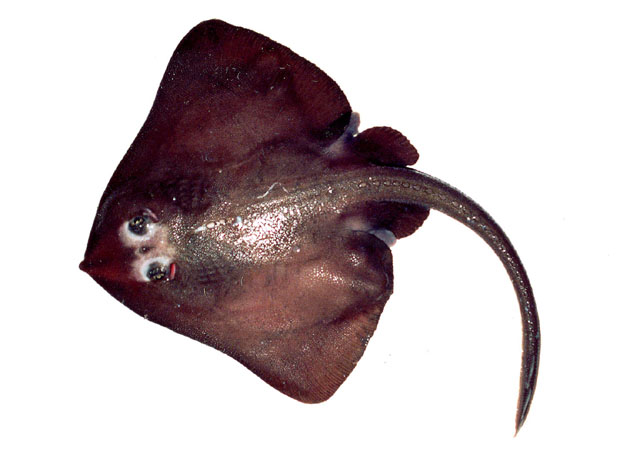Bathyraja minispinosa
Ishiyama & Ishihara, 1977
Smallthorn skate
Classification: Elasmobranchii Rajiformes Arhynchobatidae
Reference of the original description
Five new species of skates in the genus Bathyraja from the western North Pacific, with reference to their interspecific relationships. Japanese Journal of Ichthyology, 24(2), 71–90
Five new species of skates in the genus Bathyraja from the western North Pacific, with reference to their interspecific relationships. Japanese Journal of Ichthyology, 24(2), 71–90
Image of the original description
Image in copyright.
Image in copyright.
Types
Bathyraja minispinosa
Holotype: MTUF: 21872; Paratype: MTUF: 21908; MTUF: 21910; MTUF: 21909; MTUF: 21906; MTUF: 21907; MTUF: 21903; MTUF: 21904; MTUF: 21905; MTUF: 21901; MTUF: 21902; MTUF: 21899; MTUF: 21900; MTUF: 21873;
Bathyraja minispinosa
Holotype: MTUF: 21872; Paratype: MTUF: 21908; MTUF: 21910; MTUF: 21909; MTUF: 21906; MTUF: 21907; MTUF: 21903; MTUF: 21904; MTUF: 21905; MTUF: 21901; MTUF: 21902; MTUF: 21899; MTUF: 21900; MTUF: 21873;
Description :
Citation: Bathyraja minispinosa Ishiyama & Ishihara, 1977: In: Database of modern sharks, rays and chimaeras, www.shark-references.com, World Wide Web electronic publication, Version 12/2025
Please send your images of "Bathyraja minispinosa" to info@shark-references.com

Bathyraja minispinosa Ishiyama & Ishihara, 1977, © Alexei Orlov

Bathyraja minispinosa Ishiyama & Ishihara, 1977, © Alexei Orlov
Common names
 Smallthorn skate,
Smallthorn skate,  Whitebrow skate
Whitebrow skate
 Smallthorn skate,
Smallthorn skate,  Whitebrow skate
Whitebrow skate
Distribution
North Pacific: Sea of Okhotsk off Abashiri, Japan to the Kamchatka Peninsula and the Bering Sea. Source: www.gbif.org
North Pacific: Sea of Okhotsk off Abashiri, Japan to the Kamchatka Peninsula and the Bering Sea. Source: www.gbif.org
Biology
Oviparous, paired eggs are laid. Embryos feed solely on yolk [733]. Distinct pairing with embrace. Young may tend to follow large objects, such as their mother [17086]. Eggs have horn-like projections on the shell [17086]. Feeds on fish and benthic crustaceans [5868].
Oviparous, paired eggs are laid. Embryos feed solely on yolk [733]. Distinct pairing with embrace. Young may tend to follow large objects, such as their mother [17086]. Eggs have horn-like projections on the shell [17086]. Feeds on fish and benthic crustaceans [5868].
Size / Weight / Age
78.0 cm TL (male/unsexed; (Ref. ))
78.0 cm TL (male/unsexed; (Ref. ))
Remarks
shark-references Species-ID=529;
shark-references Species-ID=529;
Parasites (arranged by Jürgen Pollerspöck)
Cestoda
Cestoda
















